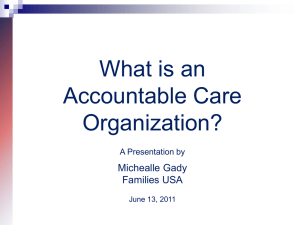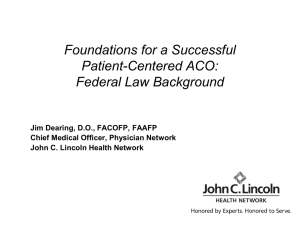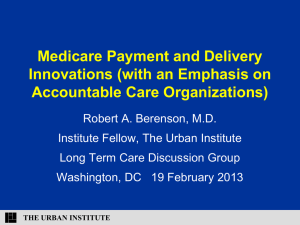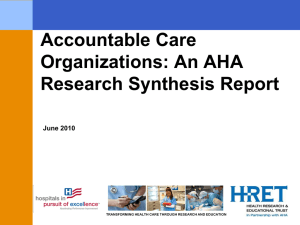ACO Proposed Rules Policy Brief May 6, 2011
advertisement
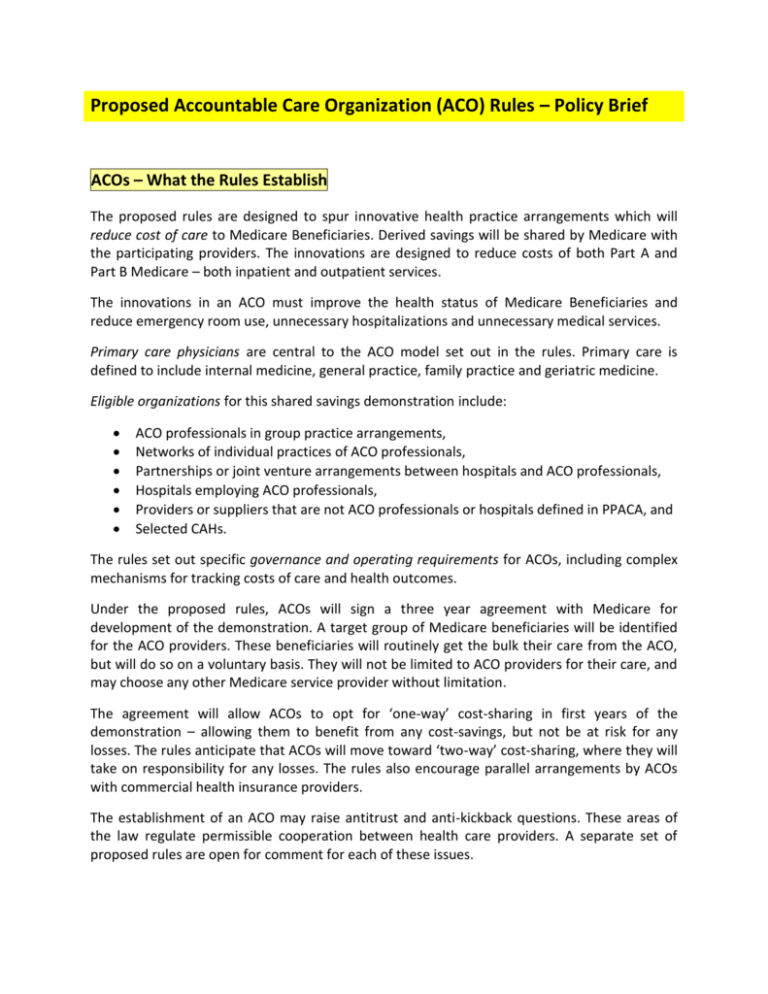
Proposed Accountable Care Organization (ACO) Rules – Policy Brief ACOs – What the Rules Establish The proposed rules are designed to spur innovative health practice arrangements which will reduce cost of care to Medicare Beneficiaries. Derived savings will be shared by Medicare with the participating providers. The innovations are designed to reduce costs of both Part A and Part B Medicare – both inpatient and outpatient services. The innovations in an ACO must improve the health status of Medicare Beneficiaries and reduce emergency room use, unnecessary hospitalizations and unnecessary medical services. Primary care physicians are central to the ACO model set out in the rules. Primary care is defined to include internal medicine, general practice, family practice and geriatric medicine. Eligible organizations for this shared savings demonstration include: ACO professionals in group practice arrangements, Networks of individual practices of ACO professionals, Partnerships or joint venture arrangements between hospitals and ACO professionals, Hospitals employing ACO professionals, Providers or suppliers that are not ACO professionals or hospitals defined in PPACA, and Selected CAHs. The rules set out specific governance and operating requirements for ACOs, including complex mechanisms for tracking costs of care and health outcomes. Under the proposed rules, ACOs will sign a three year agreement with Medicare for development of the demonstration. A target group of Medicare beneficiaries will be identified for the ACO providers. These beneficiaries will routinely get the bulk their care from the ACO, but will do so on a voluntary basis. They will not be limited to ACO providers for their care, and may choose any other Medicare service provider without limitation. The agreement will allow ACOs to opt for ‘one-way’ cost-sharing in first years of the demonstration – allowing them to benefit from any cost-savings, but not be at risk for any losses. The rules anticipate that ACOs will move toward ‘two-way’ cost-sharing, where they will take on responsibility for any losses. The rules also encourage parallel arrangements by ACOs with commercial health insurance providers. The establishment of an ACO may raise antitrust and anti-kickback questions. These areas of the law regulate permissible cooperation between health care providers. A separate set of proposed rules are open for comment for each of these issues. ACOs and Rural Health Systems – General Thoughts Rural-based ACOs are not easily accommodated under the proposed rules: The approach to ACOs set out in the proposed rules has some implications for rural health systems, but will not permit easy implementation of rural-based ACO demonstrations. Problems caused by the PPACA statute: Much of the problem stems from the PPACA statute itself, and cannot be easily remedied by modifications to the proposed rules: Minimum Size: The rules require a minimum of at least 5,000 participating Medicare beneficiaries to be part of an ACO. This minimum for each ACO presents a challenge to smaller scale rural shared savings demonstrations. Physician Focus: The rules emphasize primary care physician practice innovations. The potential contributions of non-physician providers are not fully recognized. The rules deemphasize the cost-savings and improved outcomes which can be derived from hospital operation innovations. Impact on Hospitals: Effective implementation of an ACO will lead to cost-savings derived largely from reduced hospitalizations and emergency room use. This will reduce Medicare revenues for hospitals, yet the prime benefit of any shared savings will accrue to physicians. This process of revenue transfer may have inordinate impact on rural health systems. Problems which stem from the proposed rules: Some of the problem does stem from the rules: Health Safety Net Marginalized: In calculating the beneficiary base of an ACO, the rules call for exclusion of Medicare beneficiaries who receive primary care services from RHCs, FQHCs and many CAHs. This exclusion is explained in the proposed rules as a technical matter related to how billing and cost-reports are managed in non-PPS health operations. Whatever the rationale, this exclusion will limit ACO focus on these mainstays of health care in rural areas. To their credit, the proposed rules set out some potential increased cost-sharing for those ACOs which include RHCs, FQHCs and CAHS. I am doubtful, however, whether those provisions are sufficient to offset the more important exclusion of patients from the ACO base. ACOs seeking these incentives may be more likely to make arrangements with urban-based FQHCs proximate to their core operations. Special considerations in workforce shortage areas: The rules do not address the question of health provider shortages: Outcome-Oriented Practices and Shortage Areas: Practices which operate in areas of provider surplus have a better ability to provide more comprehensive services to patients than do practices operating in chronically understaffed areas. For example, if a rural community needs four physicians to adequately serve its patients, but a local practice has only two, that practice will likely be at full capacity, providing basic acute care services to as many patients as they can. A shift in operations toward preventive medicine and health promotion, as necessitated by outcome-oriented programs, would likely require the practice to reduce services to some patients in order to permit physicians to provide expanded comprehensive services to other patients. Re-engineering of the patient visit could free up some physician time, but, in general, outcome-oriented practice in workforce shortage areas is a challenge. The persistence of chronic workforce shortages in rural areas will make ACOs and other outcomeoriented innovations more difficult to implement. Suggested NOSORH Policy Aims I would suggest that NOSORH consider two separate policy goals in preparing its comments on the proposed rules: Educate CMS about health system innovation in rural areas: Use the comment process to flag the limitations of the ACO approach for rural health systems, while emphasizing the importance of rural health systems as a test bed for high performance/cost reducing health service innovation. Suggest that separate health system innovation programs be established for rural areas – separate from the ACO demonstration. Improve incentives for participation of rural providers in ACO demonstrations: Suggest rules modifications to the current rules that could potentially increase the successful participation of health service providers – private practice, FQHC, RHC and inpatient – in larger, out of area ACOs. In accordance with these goals, I would suggest development of specific comments and recommendations in the following areas: ACO eligibility criteria: addressing how the definitions in the proposed rules impact the development of rural ACOs. Incentives for ACOs to include rural providers: addressing what types of additional incentives would lead non-rural ACOs to expand their inclusion of rural providers. Incentives for rural provider participation in ACOs: addressing what types of additional incentives would lead rural providers to participate in ACOs. Appropriateness of outcome measures to rural systems of care: reviewing the proposed outcome measures and discussing their appropriateness in a rural environment. Need for rural-specific health system cost-saving demonstrations: discussing the limits of the cost-saving approaches in the proposed rules and what types of cost-saving approaches are more appropriate for rural health systems Need for rural-specific outcome-oriented health system demonstrations: discussing approaches to health outcome improvements that are appropriate for rural areas. These comments/recommendations can be developed by policy support staff in coordination with a small NOSORH workgroup.
